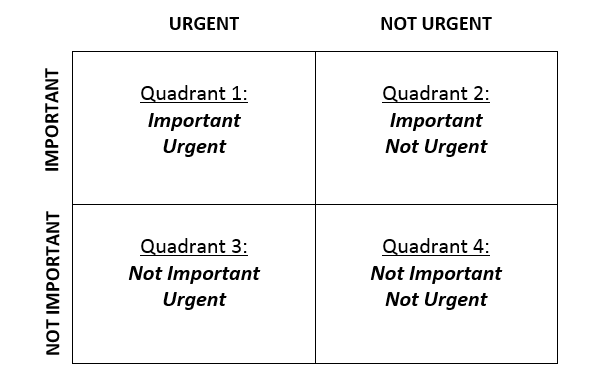Your Priority Dilemma – Urgent or Important?
I bet you have a priority dilemma when it comes to your business. You’re not sure what you should do first – what’s urgent or what’s important?
The Priority Dilemma
This is an anxiety dilemma every entrepreneur faces. With limited time and attention, which items on your to-do list should you be focusing on?
More often than not, you find yourself having to choose between the urgent and the important. If you don’t do the urgent things, you’ll fall behind. If you don’t address the important things, you’ll accomplish nothing of significance.
I bet you’re hoping I’ll resolve your priority dilemma by recommending to take care of the urgent ones first. Then focus on the important ones.
Sorry, I can’t do that. And, here’s why.
The Brain Dilemma
Your brain has an inherent brain mechanism. When something becomes urgent, you either become reactive and respond (fight) or ignore and procrastinate (flee).
When something is important, your brain is attracted and wants to focus on it. You become mentally engaged because there’s value, stimulation, creativity, or purpose in what ‘s of interest.
Both what’s urgent and what’s important are equally vying for your brain’s time, attention and mental energy.
How do successful entrepreneurs resolve the priority dilemma?
The most successful solution is a quadrant or matrix decision diagram. Each of the 4 areas designates a relationship between Important and Urgent.

The original decision matrix is credited to Dwight D. Eisenhower, former US President, General and Supreme Allied Commander in Europe during World War II.
Eisenhower summarizes his decision matrix succinctly as “What is important is seldom urgent and what is urgent is seldom important.”
What is important is seldom urgent and what is urgent is seldom important. Click To Tweet
It’s a success model with variations that business leaders Stephen Covey in 7 Habits of Highly Effective People and David Allen in Getting Things Done promote.
This matrix design is normally a quick way to sort through tasks. However, smart business leaders also use it clarify their priorities.
Important Not Urgent – priorities here are not time-sensitive but do involve being proactive in dealing with change.
- Meeting goals
- Improving systems
- Planning strategies
- Defining core values
- Making better decisions
- Creating end results
Not Important Urgent – priorities here are reactive and crisis based. They pop up continuously and by necessity are time-sensitive.
- Respond to a fast approaching deadline
- Deal with unanticipated circumstances or problems
- Interrupted by the demands of others to respond to their urgent priorities
- Stop to answer significant calls, emails or requests
Not Important Not Urgent – priorities that “feel good.”They don’t necessarily advance business as much as time spent focused on a specific priority.
- Be on every social media platform
- Respond to every media comment made
- Have to incorporate the latest shiny object offer
- Want to have comprehensive media exposure – blog, video, podcast, webinar, e-book, reports, free offers etc.
Important Urgent – priorities that make an ultimate difference
- Impact your overall success in a shorter amount of time
- Leverage your business to the next level with deadlines
- Minimize potential problems from escalating into crisis mode
- Indicate where to focus your time and energy for best results
Here’s a quick example: Cathy is an online marketer who has been working on her first affiliate product launch. Here’s a simple version of what her Eisenhower Decision Matrix might look like.
Important Not Urgent — Goal to have an affiliate product ready in the next six months
Not Important Urgent — Stop to address inquiries from previously contacted affiliate marketers
Not Important Not Urgent — Need to start planning for the next affiliate product
Important Urgent — Complete a series of smaller goals with a weekly deadline.
Priority Dilemma Solved in Four Steps
First, have some form of a business planner to help organize a to-do list.
Second, decide which items should be important priorities.
Third, know that urgent priorities will occur demanding immediate action.
Fourth, use the decision matrix to clarify your priorities. Some will be easy to schedule, while others will require a certain amount of motivation to kick into action mode.
The value of a decision matrix is that it —
- allows you to take an important priority and treat it as a meaningful urgent priority.
- gives your brain time, attention, and mental energy to focus on your important and urgent priority.
- lets urgent priorities wait to be addressed during breaks in your schedule.
- provides for your other important priorities to have a greater chance of completion.
- puts in place an important and urgent priority system.
- frees up any anxiety about having a priority dilemma over what’s important or urgent.
What does your priority list look like?
Are there still some priorities waiting for you to take action on?
Resources:
https://metabroadcast.com/blog/the-difference-between-urgent-and-important-things
https://www.evernote.com/shard/s293/res/b254ce25-88e5-4535-842a-6e474aeabe05
http://www.artofmanliness.com/2013/10/23/eisenhower-decision-matrix/
Image Credit: http://www.jamesattorneymarketing.com/wp-content/uploads/2016/04/Chart.png; Pixabay 1714375
